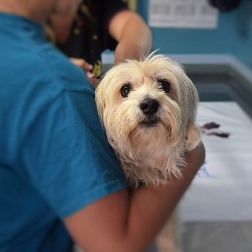How to Pick a Vet Tech Program near Santiago Minnesota
 Realizing your lifelong dream of working with and helping pets by enrolling in a vet tech college near Santiago MN could at first seem like a challenging endeavor. After all, you must locate and enroll in a program that will furnish the appropriate training to ensure that you can be successful as a vet tech. But just how do you tackle analyzing and contrasting colleges so that you can make the best selection? Many future students start their due diligence process by looking for schools that are close to their homes. When they have identified some area colleges, they determine which ones have the lowest tuition and focus on those. Although cost and location are important concerns when evaluating vet tech schools, they are by no means the only important ones when making your assessments. Qualifiers such as internship programs and accreditation should be looked into as well. The point is that there are questions you ought to be asking the vet technician programs you are looking at before you make a final decision. We have furnished several within this article to help get you started, but before we discuss them we’ll go over the different roles of vet techs and the training options offered.
Realizing your lifelong dream of working with and helping pets by enrolling in a vet tech college near Santiago MN could at first seem like a challenging endeavor. After all, you must locate and enroll in a program that will furnish the appropriate training to ensure that you can be successful as a vet tech. But just how do you tackle analyzing and contrasting colleges so that you can make the best selection? Many future students start their due diligence process by looking for schools that are close to their homes. When they have identified some area colleges, they determine which ones have the lowest tuition and focus on those. Although cost and location are important concerns when evaluating vet tech schools, they are by no means the only important ones when making your assessments. Qualifiers such as internship programs and accreditation should be looked into as well. The point is that there are questions you ought to be asking the vet technician programs you are looking at before you make a final decision. We have furnished several within this article to help get you started, but before we discuss them we’ll go over the different roles of vet techs and the training options offered.
The Function of a Vet Tech in Santiago MN
 Among the initial decisions that you will need to make is if you want to train as a veterinary assistant, technologist or technician. Part of your decision may be dependent on the amount of time and money that you have to invest in your training, but the principal factor will undoubtedly be which specialty interests you the most. What techs and assistants have in common is that they both work under the direct supervision of a practicing and licensed veterinarian. And while there are a number of functions that they can perform within the Santiago MN veterinary clinic or hospital, they can’t prescribe drugs, diagnose conditions, or carry out surgical procedures. In those areas they can only provide support to a licensed veterinarian. There are technicians and technologists that work exclusive of the typical vet practice, such as for animal shelters, zoos or police departments. Let’s take a look at the job functions and education requirements for each position.
Among the initial decisions that you will need to make is if you want to train as a veterinary assistant, technologist or technician. Part of your decision may be dependent on the amount of time and money that you have to invest in your training, but the principal factor will undoubtedly be which specialty interests you the most. What techs and assistants have in common is that they both work under the direct supervision of a practicing and licensed veterinarian. And while there are a number of functions that they can perform within the Santiago MN veterinary clinic or hospital, they can’t prescribe drugs, diagnose conditions, or carry out surgical procedures. In those areas they can only provide support to a licensed veterinarian. There are technicians and technologists that work exclusive of the typical vet practice, such as for animal shelters, zoos or police departments. Let’s take a look at the job functions and education requirements for each position.
- Vet Assistants in almost all cases will have completed a formal training program, either as an intern or apprentice in a practice, or by graduating from a certificate program at a community college or trade school. As the name implies, their job function is to assist the vets and vet techs in the performance of their duties. Normally they are not associated with more involved undertakings, for instance assisting with surgeries. A few of their typical duties may include working at the front desk, cleaning and preparing exam rooms and equipment, or controlling pets during examinations.
- Vet Technicians receive more advanced training compared with assistants and generally earn a 2 year Associate Degree, preferably from an American Veterinary Medical Association (AVMA) accredited program. They are in a sense the vet counterparts of medical nurses, since their general job function is to assist veterinarians with diagnosing and treating animal patients. Where they stand apart from vet assistants is that they are involved in more involved tasks, for example assisting with surgeries or providing medication. All states presently mandate that veterinary technicians pass a credentialing exam for either licensing, registration or certification.
- Vet Technologists are similar to vet technicians and basically perform the same job functions. They are mandated to earn a Bachelor’s Degree in veterinary technology, which generally takes four years to complete. Therefore the main difference between a vet technician and a technologist is the technologist’s more advanced level of education. But with an advanced degree comes more career opportunities, higher salaries and possible management positions. They are additionally required to pass a credentialing examination for either licensing, registration or certification.
Vet techs and technologists can specialize in areas such as internal medicine, anesthesia or urgent care. Many may receive certification from the American Association for Laboratory Animal Science (AALAS) to work in Santiago MN labs or research facilities also.
Online Veterinary Technician Schools Offered in Santiago
 An alternative that may be a solution for those with a hectic schedule or who are working full time while attending veterinarian college is to enroll in an online training program. Since the classes are offered by means of the internet, students can study on their own schedule wherever a computer is accessible. The course of study is taught using multiple venues, including slide shows, videos and live streaming webinars. And since most vet technician and technologist degrees require practical training, that segment can usually be carried out as an internship or work study program at a local Santiago MN veterinarian practice or hospital. Distance learning, as it is also called, can in some instances lower the cost of your education. Tuition and secondary expenditures, such as for travel and study supplies, may be lower compared to more conventional classroom courses. Just confirm that the online school that you select is accredited, either by the AVMA or another nationally certified accrediting organization. With the online classes and the practical training, everything is included for a comprehensive education. So if you are disciplined enough to learn in this more self-reliant manner, an online vet tech school may be the ideal option for you.
An alternative that may be a solution for those with a hectic schedule or who are working full time while attending veterinarian college is to enroll in an online training program. Since the classes are offered by means of the internet, students can study on their own schedule wherever a computer is accessible. The course of study is taught using multiple venues, including slide shows, videos and live streaming webinars. And since most vet technician and technologist degrees require practical training, that segment can usually be carried out as an internship or work study program at a local Santiago MN veterinarian practice or hospital. Distance learning, as it is also called, can in some instances lower the cost of your education. Tuition and secondary expenditures, such as for travel and study supplies, may be lower compared to more conventional classroom courses. Just confirm that the online school that you select is accredited, either by the AVMA or another nationally certified accrediting organization. With the online classes and the practical training, everything is included for a comprehensive education. So if you are disciplined enough to learn in this more self-reliant manner, an online vet tech school may be the ideal option for you.
Things to Ask Santiago MN Vet Tech Schools
 At this point you should have determined which veterinarian degree that you want to obtain, and if you intend to study online or attend a college on campus. Since there are a large number of veterinarian community colleges, trade and vocational schools in the Santiago MN area and across the USA, you need to ask some relevant questions to help narrow down your list of alternatives. As we pointed out in our opening, many potential students start by focusing on location and tuition expense. But we have already pointed out other essential qualifiers, such as internship programs and accreditation. And of course you need to choose a program that offers the degree and specialty that you want to earn. These and other factors are reviewed in the list of questions that you should ask the veterinary technician programs that you are considering.
At this point you should have determined which veterinarian degree that you want to obtain, and if you intend to study online or attend a college on campus. Since there are a large number of veterinarian community colleges, trade and vocational schools in the Santiago MN area and across the USA, you need to ask some relevant questions to help narrow down your list of alternatives. As we pointed out in our opening, many potential students start by focusing on location and tuition expense. But we have already pointed out other essential qualifiers, such as internship programs and accreditation. And of course you need to choose a program that offers the degree and specialty that you want to earn. These and other factors are reviewed in the list of questions that you should ask the veterinary technician programs that you are considering.
Is the Vet Program Accredited? It’s essential that you verify that the veterinary technician program you enroll in is accredited by a regional or national accrediting agency. As earlier discussed, among the most highly regarded is the American Veterinary Medical Association (AVMA). Vocational schools and colleges that are accredited by the AVMA have undergone a demanding review process that confirms you will get a superior education. Also, accreditation is important if you are applying for a student loan or financial assistance, since a large number of programs are not offered for non-accredited programs. Last, having a degree or certificate from an accredited program is frequently a requirement for employment for a number of Santiago MN area vet clinics and hospitals.
What is the College’s Reputation? The veterinary trade school or college and program you choose should have an outstanding reputation within the veterinarian community. You can begin your due diligence by asking the schools you are reviewing for testimonials from the employers in their job placement network. Other tips include looking on internet school ranking websites and checking with the school’s accrediting organizations as well. You can ask the Minnesota school licensing authority if there have been any complaints or infractions concerning your targeted schools. As a final recommendation, phone some Santiago MN veterinary clinics that you might wish to work for after you go through your training. Ask what they think of your school choices. They might even recommend one or more schools not on your list.
Are there Internship Programs? The best means to get practical hands on experience as a vet tech is to work in a professional environment. Find out if the schools you are considering have internship programs established with Santiago MN veterinarians, vet hospitals or clinics. Most veterinary medicine programs mandate practical training and a large number furnish it by way of internships. Not only will the experience be valuable regarding the practical training, but an internship can also help establish connections in the local veterinarian community and aid in the search for a job after graduation.
Is Job Assistance Provided? Searching for a job after graduating from a veterinary technician school can be difficult without the help of a job placement program. To begin with, ask what the graduation rates are for the programs you are evaluating. A lower rate could signify that the teachers were unqualified to teach the curriculum or that some students were disappointed with the program and dropped out. Next, verify that the colleges have a job assistance program and find out what their placement rates are. A high placement rate could mean that the program has an excellent reputation within the Santiago MN veterinarian community and has a substantial network of contacts for student placements. A low rate might signify that the training is not highly regarded by employers or that the job assistance program is a failure at placing students.
How Large are the Classes? If the classes are bigger, you may receive little or no personalized instruction from the teachers. Solicit from the Santiago MN schools you are looking at what their classroom student to teacher ratios are. You may also decide to sit in on a couple of classes (if practical) to observe the interaction between students and instructors. Ask for feedback from students concerning the quality of instruction. Also, speak with the instructors and find out what their qualifications are as well as their methods of teaching.
Where is the Campus Located? Yes, we previously discussed location, but there are a few more points to make on the subject. If you are going to commute to your veterinary technician classes from your Santiago MN home, you have to make sure that the driving time fits into your schedule. For instance, driving during the weekend to check out the route won’t be the same as the drive during rush hour traffic, especially if the campus is located in or near a large city. In addition, if you do opt to attend a college in another state or even outside of your County of residence, there may be increased tuition charges particularly for community and state colleges. Of course attending classes online may be an alternative that will give you more flexibility and decrease the need for travel.
Do the Classes Fit Your Schedule? And last, it’s important that you determine if the vet colleges you are exploring offer class times that are sufficiently flexible to accommodate your schedule. For example, a number of students continue working full time and can only go to classes on the weekends or in the evenings near Santiago MN. Others may only be able to attend classes in the morning or in the afternoon. Make certain that the class times you need are available before enrolling. Also, find out if you can make up classes that you might miss as a result of work, sickness or family issues. You might find that an online program is the best way to fit your veterinary training into your busy life.
Enrolling in a Vet Tech School near Santiago MN?
If you have decided to attend a Veterinary Technician Program in the Santiago Minnesota area, then you may find the following information about the location of your school campus interesting and informing.
Santiago Township, Sherburne County, Minnesota
According to the United States Census Bureau, the township has a total area of 36.3 square miles (94.1 km²); 36.1 square miles (93.5 km²) of it is land and 0.2 square miles (0.6 km²) of it (0.63%) is water.
As of the census[1] of 2000, there were 1,555 people, 477 households, and 395 families residing in the township. The population density was 43.1 people per square mile (16.6/km²). There were 483 housing units at an average density of 13.4/sq mi (5.2/km²). The racial makeup of the township was 98.39% White, 0.26% African American, 0.19% Native American, 0.13% Asian, 0.06% from other races, and 0.96% from two or more races. Hispanic or Latino of any race were 0.26% of the population.
There were 477 households out of which 53.2% had children under the age of 18 living with them, 74.2% were married couples living together, 3.8% had a female householder with no husband present, and 17.0% were non-families. 12.4% of all households were made up of individuals and 3.1% had someone living alone who was 65 years of age or older. The average household size was 3.18 and the average family size was 3.46.
Pick the Best Vet Tech School near Santiago MN
 Picking the appropriate veterinary technician program is a critical first step to starting a fulfilling career providing care and treatment for animals. Students thinking about veterinary technician programs need to make their determination based on multiple key factors. Veterinary technicians and technologists are employed in vet clinics, animal hospitals and animal shelters. They typically handle administrative tasks and support the veterinarian with the animals as needed. As we have discussed, it’s imperative that you decide on a veterinary medicine program that is both accredited and has an outstanding reputation within the profession. This applies to vet tech online colleges as well. By asking the questions provided in our checklist for reviewing schools, you will be able to narrow down your options so that you can make your final decision. And by picking the best school, you can accomplish your goal of becoming a vet tech in Santiago MN.
Picking the appropriate veterinary technician program is a critical first step to starting a fulfilling career providing care and treatment for animals. Students thinking about veterinary technician programs need to make their determination based on multiple key factors. Veterinary technicians and technologists are employed in vet clinics, animal hospitals and animal shelters. They typically handle administrative tasks and support the veterinarian with the animals as needed. As we have discussed, it’s imperative that you decide on a veterinary medicine program that is both accredited and has an outstanding reputation within the profession. This applies to vet tech online colleges as well. By asking the questions provided in our checklist for reviewing schools, you will be able to narrow down your options so that you can make your final decision. And by picking the best school, you can accomplish your goal of becoming a vet tech in Santiago MN.
Other Doggone Good Cities in Minnesota
Business Results 1 - 10 of 17














